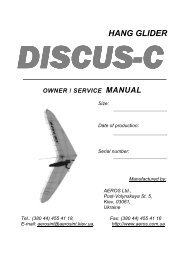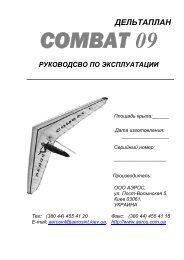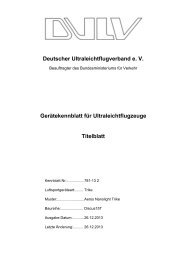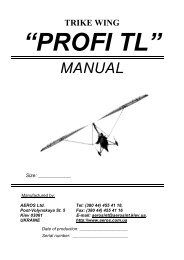Create successful ePaper yourself
Turn your PDF publications into a flip-book with our unique Google optimized e-Paper software.
Some degree of fatigue due to repeated bending of cables is almost unavoidable in an aircraft<br />
that is assembled and disassembled with every flight. Bottom side wires are subject to the<br />
highest loads in flight, and are therefore the most critical.<br />
4.3. CHECKING THE TUBINGS<br />
To check the condition of the wing tubes the sail should be removed from the wing frame and<br />
the tubes should be detached at the joints. The tubes are to be inspected visually. When there<br />
is suspicion of damage, the points in question should be inspected using a magnifying glass of<br />
(5-10)X magnification. There should be no trace of corrosion, cracks, bends or dents.<br />
4.4. CHECKING THE BATTENS<br />
The batten profiles should be checked against the template and the bends should be adjusted if<br />
necessary. Check all the plastic batten heads and tails and replace if necessary.<br />
4.5. FASTENERS<br />
Check all fasteners (bolts, screws, rollers, nuts, splint pins etc.) for corrosion. Any corroded<br />
fasteners should be replaced. Bolts should not be worn and/or bent. Key bolts should be<br />
checked most thoroughly for cracks between the head and the bolt body. These are the bolts at<br />
the control bar side and bottom joints, the central spreader bar tensioning cable attach point<br />
and the rear cable attachment point on the keel tube. If any cracks are observed - REPLACE<br />
IMMEDIATELY!<br />
Section 5. MAINTENANCE<br />
5.1. MAINTENANCE<br />
• With correct maintenance your wing will retain its good condition for many years.<br />
• We recommend that do you not expose your wing to any more direct sunlight than necessary.<br />
Do not leave it standing in the sun for long periods of time when you are not flying it.<br />
• Do not leave your wing on the trike for a long period of time when the wind is strong. It will<br />
decrease the life of the sail, hang junction and frame of your wing.<br />
• Your wing should be dried thoroughly after being exposed to rain or any other source of<br />
moisture.<br />
• Your sail should never be washed with anything other then fresh water, as any soap or<br />
detergent will most likely degrade the cloth and may adversely affect the flight characteristics of<br />
your wing.<br />
• When you set up or break down your wing, take care not to allow sand, soil and dirt to enter<br />
the sail, batten pockets or tubes. Keep the leading edge tube telescopic connectors thoroughly<br />
clean as set up or break down will become difficult or impossible if they are dirty. Swab the<br />
tubes with a rag.<br />
• Keep all the wing’s foam padding that was originally supplied and use in the same places<br />
when re-packing the wing.<br />
5.2. STORAGE<br />
• You must store the wing in its bag in a dry place on soft bedding. Before storage you must<br />
ensure that the sail is dry.<br />
• The frame of the wing must not be subjected to load during storage and the tubes must not be<br />
bent under their own weight.<br />
• The wing can be storage in temperatures ranging from -10°C to +25°C.<br />
5.3. TRANSPORTATION<br />
• The wing may be transported in its bag in any vehicle that offers protection from mechanical<br />
damage, soiling and long exposure to rain. It is not recommended that the wing be carried or<br />
transported without its bag.<br />
27









